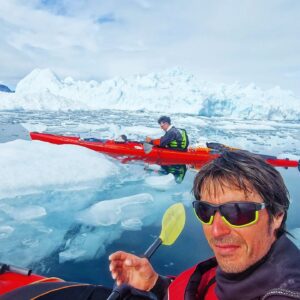Marcin Tomaszewski and Pawel Haldas “fell in love with a frozen piece of rock,” Greenland got its first big wall winter climb, and the two Poles escaped narrowly with their hides.
Oqatssut is one hell of a massif: overlapping, glacier-protected, and hulking. The two climbers targeted it on instinct but reaching it in winter was a travail. So was getting out before the surrounding sea ice broke up.
They called their route Fram, after Fridtjof Nansen’s polar ship. The locals’ name for the wall is Oqatssut. Tomaszewski and Haldas climbed it in February: 17 pitches, 700 meters, M5, A3, C2, VI Big Wall 10-24.02.

Bitter cold was a constant enemy. So was loose rock, darkness, the waning winter, dangerous climbing, and, well…pretty much everything. But you wouldn’t know it from Tomaszewski.
“We didn’t experience any bad moments. We knew what to expect in this place and we were prepared both physically and mentally. We knew that the wall might be fragile and we assumed it would be cold,” he said. “No amount of physical exertion or endurance could have given me a greater feeling of accomplishment.”
Weather forces pivot, locals lead the way
It’s the first reported winter ascent of a Greenland big wall and like the voyage of its namesake ship the Fram, perseverance defined its authorship.
Oqatssut thrusts from the sea in a big inlet near the picturesque West Greenland town of Uumaanaq. Local hunters pointed Tomaszewski and Haldas to the area.

Uumannaq in summer. Photo: Jerry Kobalenko
But it wasn’t the climbers’ first choice. Oqatssust was a forced decision.
The team had targeted Agpat, Uumaanaq, and Storoen Island. Decaying ice forced an adjustment.
“The tactics we had set up and the areas where we were going to look for our walls landed in the trash a moment after arrival,” Tomaszewski explained on Facebook. “The ice cover on the fiords is not constant. It is influenced both by the air temperature and by the wind pushing warm water from Baffin Bay.”
Undeterred, he and Haldas pivoted on the local advice. A compulsion based on something beyond pragmatism propelled them.
“We looked for it instinctively, without a map. It was a real journey into the unknown, just like in the times of the first explorers that I read about as a child. At that moment I felt like the child I was, dreaming of such discoveries,” Tomaszewski said. “For me, the greatest moment of the trip was this moment.”

Photo: Marcin Tomaszewski
Stoic progress
They pitched their tents at the base of the formation on February 9 and headed up the next day. Temperatures plummeted to -40°C during the 17 hours of night they experienced each day. Locals marked the low temperatures as exceptional.
“Climbing the lower part of the wall was not technically difficult but was very demanding because of loose rock,” Tomaszewski wrote. “Black bands of rock enveloping the wall at two levels meant poorer quality granite and a high risk of spontaneously falling fragments. The short seven-hour day meant that we were unable to complete more than one or two pitches a day, either by aid climbing or free climbing up to M5.”
They proceeded methodically. Tomaszewski relied on significant winter climbing experience as he and Haldas weathered the conditions.
“We had to check our fingers and toes every minute of the climb. A moment of inattention would result in frostbite.
“After my previous winter climbs in the Karakoram, Baffin Island, and Norway, I knew we couldn’t make this mistake,” Tomaszewski said. “And we didn’t.”
All in, it was 14 days up and down the wall — leading and fixing pitches, creating bivouacs, and staying warm.
“One wears light clothes and moves all day, while the belayer wears his warmest down clothes to survive a day on the wall,” Tomaszewski wrote. “The cold is our biggest opponent. After a moment of rest, the body cools down, cutting the heat from our fingers, which then requires warming them up again and again. There must always be time for this!”

Photo: Marcin Tomaszewski/Facebook
‘Black magic of climbing’
Haldas drew the stiffest pitches, but that didn’t mean Tomaszewski was out of harm’s way. Continued Tomaszewski:
The cavernous weaknesses in the wall forced us to do some real acrobatics and reach for the black magic of climbing. After passing the second visible strip of black rock, Pawel pushes on to the demanding A3 pitch. I can hear the rumbling flakes and see thin slabs stuck to the wall, and I am standing directly underneath them! I feel like a condemned man under the guillotine.
This pitch took Pawel a good couple of hours in silence. He climbed in terrible wind and spindrift. He was extremely brave, I was proud of him. Thanks to this progress…we had the chance to summit the next day, on the last day of good weather.
From the summit, Tomaszewski contemplated the scene below him.
“The icebergs below us, trapped in the frozen fiord, looked insane…it’s hard to describe what we felt, what we saw. This moment was composed of many brief moments from the past days, months, and life. It is impossible to describe,” he said.

Photo: Marcin Tomaszewski
Narrow escape
There was no time to linger at the top. Forecasts called for punishing 110kmph gusts, and the ice entrapping Oqatssut would not last. ExplorersWeb reported that the climbers scrambled down the wall to arrive at the base at noon on Feb. 23. There they met a hunter, who hustled them back to Uumannaq.
The sea ice broke up an hour later, as the wind began to hammer the cliff.
“We can’t imagine what would have happened if we hadn’t made it,” Tomaszewski said.

Sea ice differences in 24 hours. Photo: Marcin Tomaszewski
Shifts this rapid can happen in Western Greenland when warm water and wind plow in from the Gulf Stream. Tomaszewski was judicious in describing the potential consequences of getting trapped.
“The thought kept running through my mind that a one-day delay might have resulted in us being cut off from the world for longer than we would have liked,” he said. “We were extremely lucky.”

Reflections from the portaledge. Photo: Marcin Tomaszewski
The climbers walked away with a landmark Greenland climb. It was a vindicating effort for Tomaszewski, who has long held a special connection with the world’s largest island.
“This expedition closed a certain process around my long-term relationship with Greenland, during which I always felt at home,” he said. “Because of its wildness and the small number of climbers, this island is one of the places where I feel safe. In life, I follow my heart more than my mind, and it is my heart that has always shown me the way north.”
The climbers created a film, somewhat improvisationally, along the way. INUSSUK is playing on the festival circuit now, promoted by the industrious Tomaszewski.
Inussuks are stone markers created in the image of humans, signifying contact with the land.
It is worth a watch.






